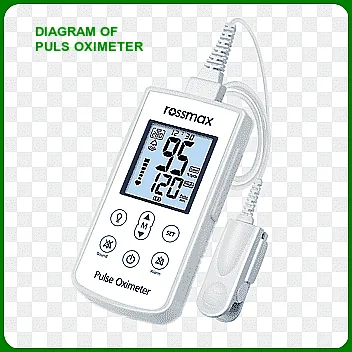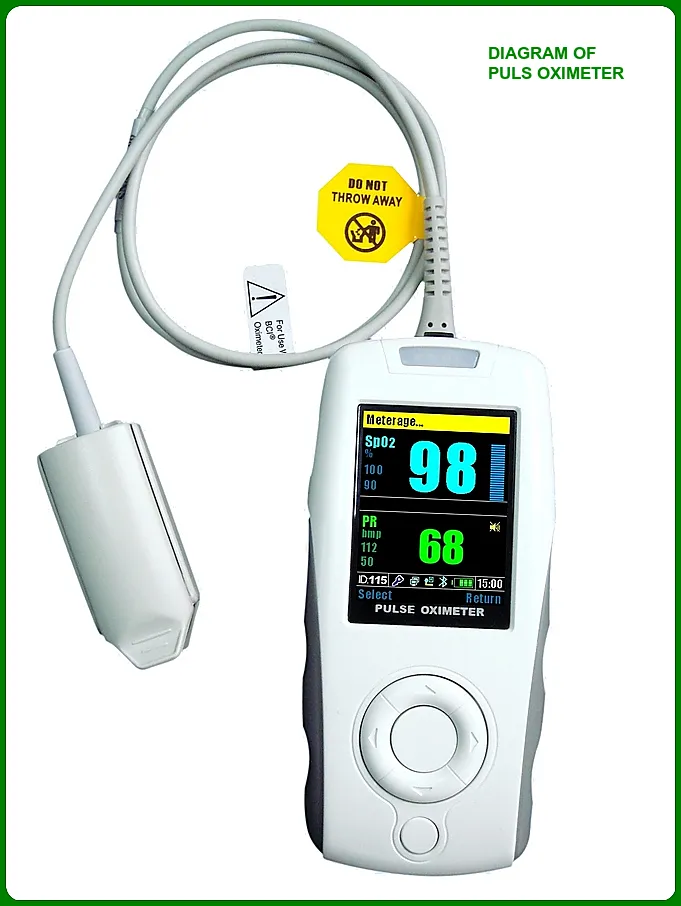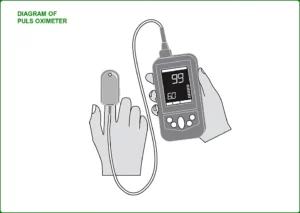What is pulse oximeter?
A pulse oximeter is a small, portable device designed to measure the oxygen saturation level in a person’s blood. It’s a non-invasive tool that clips onto a person’s fingertip, toe, or earlobe, emitting two wavelengths of light through the skin. The device then detects the amount of oxygen in the blood by analyzing the light absorption.
The key parameter measured by a pulse oximeter is oxygen saturation (SpO2), expressed as a percentage. This indicates the percentage of hemoglobin in the blood that is carrying oxygen. Typically, a normal SpO2 level is around 95-100%. Additionally, pulse oximeters often display the person’s heart rate (pulse) alongside the oxygen saturation level.
Pulse oximeters are widely used in various healthcare settings, including hospitals, clinics, and home care. They are also valuable for individuals with respiratory conditions, such as chronic obstructive pulmonary disease (COPD), asthma, or those recovering from surgery. The device provides a quick and convenient way to monitor oxygen levels, helping healthcare professionals and individuals assess respiratory function and respond promptly to any issues.
What is the benefit of pulse oximeter?
A pulse oximeter is a device used to measure the oxygen saturation of the blood in patients with low oxygen levels. It is used to measure blood oxygen saturation to diagnose and monitor various conditions in the patient.
The pulse oximeter offers several benefits, making it a valuable tool in healthcare:
- Oxygen Saturation Monitoring:
- Provides real-time measurement of oxygen saturation (SpO2) levels in the blood, helping assess how well oxygen is being transported to the body’s tissues.
- Early Detection of Respiratory Issues:
- Enables early detection of respiratory problems or conditions that may affect oxygen levels, such as pneumonia, asthma, or chronic obstructive pulmonary disease (COPD).
- Monitoring Oxygen Levels in Critical Situations:
- Essential for monitoring patients during surgeries, in intensive care units (ICUs), or during emergency situations to ensure they receive adequate oxygen.
- Home Monitoring:
- Allows individuals with chronic respiratory conditions to monitor their oxygen levels at home, providing timely information for self-management and potentially preventing complications.
- Screening for Sleep Apnea:
- Used in sleep studies to assess oxygen levels during the night, aiding in the diagnosis of sleep apnea and other sleep-related respiratory disorders.
- Fitness and Altitude Training:
- Utilized by athletes and individuals involved in fitness activities to monitor oxygen levels during workouts, and by those training or acclimating to high altitudes.
- Easy to Use and Non-Invasive:
- Provides a quick and painless method for oxygen level assessment without the need for blood samples or invasive procedures.
- Compact and Portable:
- The small size and portability of pulse oximeters make them convenient for use in various settings, including homes, hospitals, clinics, and ambulances.
- Remote Patient Monitoring:
- Facilitates remote monitoring of patients, allowing healthcare providers to assess and track oxygen levels without the need for frequent in-person visits.
How to work pulse oximeter
It measures the level of oxygen in the blood. It is often used to measure the level of oxygen saturation in the blood. It is often used as part of a medical or home monitoring system.
Using a pulse oximeter is a straightforward process. Here’s a step-by-step guide on how to work a typical pulse oximeter:
- Prepare the Device:
- Ensure the pulse oximeter is clean and in good working condition.
- Check and insert the batteries if required.
- Insert Finger:
- Place your hand comfortably, and if using a fingertip pulse oximeter, insert your finger into the device. Ensure the nail bed is facing up.
- Power On the Device:
- Turn on the pulse oximeter using the power button.
- Wait for Readings:
- The pulse oximeter will start reading your oxygen saturation (SpO2) levels and heart rate. This process usually takes a few seconds.
- View the Readings:
- Once the readings stabilize, you will see your oxygen saturation level as a percentage and your heart rate in beats per minute (BPM) displayed on the screen.
- Interpret the Results:
- A normal SpO2 level is typically between 95% and 100%. However, it’s essential to consider individual health conditions and consult healthcare professionals for personalized interpretation.
- Record the Readings (if necessary):
- Some individuals may need to record their SpO2 levels regularly. If this is the case, jot down the readings for future reference or share them with healthcare providers.
- Power Off the Device:
- Turn off the pulse oximeter to conserve battery power.
Important Tips:
- Ensure your hands are clean and dry before using the pulse oximeter.
- Avoid excessive movement during the reading for accurate results.
- If using a clip-style pulse oximeter, make sure it is securely attached to your fingertip or earlobe.
- If you have any concerns or questions about the readings, consult with a healthcare professional.
Article About:- Health & fitness
Article About:- Medical Technology
Article About:- Sports

What is Pulse Oximeter and How Do They Work?
Pulse oximeters are used to measure oxygen saturation in the blood, which is a good way to measure one’s saturation levels of oxygen.
This information is useful for people who have difficulty breathing, as it can help them know when their oxygen levels have decreased. Some medical professionals use them to monitor patients who have difficulty with their normal breathing.
Why a pulse oximeter is used
Pulse oximeters are devices that measure oxygen saturation in the blood. They are used to measure your oxygen levels and are especially useful for people who are experiencing shortness of breath, chest pain, and other symptoms related to low oxygen levels.
They are also used to monitor the oxygen levels of newborns and infants. A pulse oximetr is a small, handheld device that can be used to take a reading of your blood oxygen levels, which are expressed in a percentage.
What are the different types of pulse oximeters?
A pulse oximetr is a small electronic device that measures the oxygen saturation of your blood. It is commonly used as a medical device. The device is often used to monitor patients who have a medical condition that affects their oxygen saturation.
The device is also used to monitor patients who are at risk of having a medical emergency like heart attack, stroke, or respiratory failure. The pulse oximetr is used for a variety of medical applications such as: – To measure the oxygen saturation of the blood –
To monitor patients who are at risk of having a medical emergency – To monitor patients who have a medical condition that affects their oxygen saturation – To monitor patients who are suffering from an illness – To monitor patients who are recovering from an illness
A pulse oximetr is a device that measures the oxygen level in the blood by using the light absorption principle of oxygen sensors. The sensor is placed on the finger, earlobe, or forehead, and there is a light source near the sensor.
As the light passes through the tissue, the sensor detects how much oxygen is in the tissue. A pulse oximetr is a device that is used to measure the oxygen level in the blood.

FAQ
Which finger to use for pulse oximeter
Your pulse oximeter is usually placed on your index or middle finger because they have a good blood supply and are easily accessible. Occasionally, you may be able to use the thumb or ring finger if the index or middle finger are not available or suitable. Different pulse oximeters may offer slightly different recommendations, so it’s important to follow the instructions provided by the manufacturer.
How to read a pulse oximeter
Check that your hands and fingertips are clean before inserting your finger into the pulse oximeter. Artificial nails or nail polish can interfere with the accuracy of the reading, so try to avoid them when possible. Make sure the device fits snugly on your fingertip and then turn it on. You may have to wait a few seconds for it to start working as it measures your pulse rate and oxygen saturation level; two key values will be shown on the screen when it stabilizes.
How to use pulse oximeter
To obtain an accurate reading, ensure that your hands and fingers are free from any nail polish or artificial nails. Additionally, firmly insert the pulse oximeter into your fingertip, earlobe or toe, depending on the design of the device. While it is measuring, stay still and avoid any unnecessary movements. Afterwards, check the results displayed on the screen.
What is a pulse oximeter used for?
Without the need for needles or blood samples, the pulse oximeter measures the oxygen saturation level in your body quickly. The measured amount that appears on the screen indicates the oxygen saturation level of your red blood cells. Your treatment plan is outlined in this number for the benefit of your physicians and nurses.
What is pulse oximeter normal range?
What do specific results from a pulse oximeter mean? A healthy individual at sea level is thought to have a resting oxygen saturation level of between 95% and 100%. Oxygen saturation levels may be somewhat lower at higher altitudes.
What are the 2 readings on a pulse oximeter?
A pulse oximeter is a piece of equipment that is often worn on the fingertips. It measures the pulse rate and blood oxygen saturation using laser beams. Information on the quantity of oxygen transported in the blood is provided by oxygen saturation.
What is BP rpm in oximeter?
The term “pulse” describes the heart’s frequency of beats per minute. An oximeter’s pulse rate provides the heart rate in beats per minute. A healthy pulse rate is ideally between 60 and 100 beats per minute.


